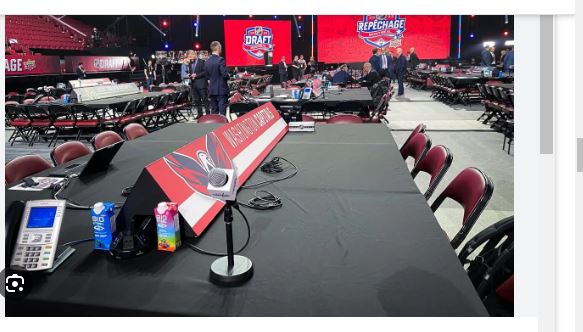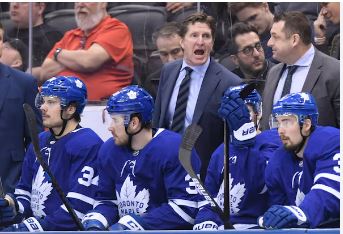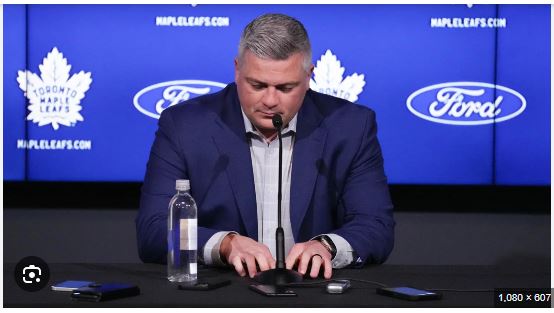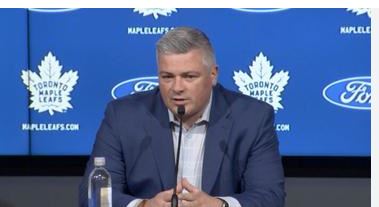All bets are off when the fifth round arrives. You’re just getting to the guys that certain teams, for whatever reason, still genuinely enjoy more than other teams, so rankings really don’t matter as much. Furthermore, there are even more disparities in viewpoints regarding that amongst teams than there are between various media outlets.
You’re not talking about players with high floors and great skills who have very clear routes to the NHL at that stage in the draft. You’re talking about men who are either in smaller positions or lower levels, who produce decent but not spectacular results, who may have one or two remarkable abilities, or who are simply ok all-around players. Their shortcomings are more glaring, and they need to develop far more to be considered serious NHL prospects. A notable illustration of this is Noah Chadwick. Despite his stature and skill, he struggled with skating and had a lackluster draft year.
Essentially, what you’re looking for is a hidden gem—someone who, for whatever reason, escaped the attention of other teams—or players who become those great development hits and winners—people like Nikita Grebyonkin, Andreas Johnsson, Pierre Engvall, and so on.
Though the most likely conclusion is probably not even an NHLer at all, I’m looking at people who have some combination of abilities and skills that I can see perhaps evolving into anything. At best, that might be bottom six NHL depth.
Let’s start with a few forwards that, in my opinion, Toronto may consider as solid swing picks but who are more likely to end up as fifth-round or later prospects.
In Russia, Avramov is a large and skilled forward. With a good and hard shot and the potential for a good power game, he plays a fast and heavy game as a 6’3″ wrecking ball. He makes good use of his size and physical attributes, and some scouting reports have him listed as a dual-threat offensively—a shooter and a passer. He’s a versatile goal scorer, possessing both a good shot and the willingness and ability to get dirty goals around the net and just cause chaos. He killed penalties, participated in their top powerplay, and played a lot (19:24 TOI).
He led his team in points by a 15, in goals by 8, and in shots on goal by 34. He tied for 15th in the MHL for his age group in points, and he was tied for 5th in goals. He is a lot of fun and I think has a lot more promise in his game than he’s gotten credit for, even though he’s still a bit of a project. He had 23 goals and 44 points in 49 games, and from what I had seen the majority of his assists were primary. On one of the worst teams in the league.
In all honesty, I didn’t have Avramov in my full profiles when I first started, but after giving him another look for this, I’m glad I did. I think he’s a really good player, and if he’s available, I’d take him with a fourth round pick because, as of right now, hardly anyone ranks him at all. Here are some of his highlights; he’s ranked #56 in each of them.
Spellacy is an intriguing player; he is from Ohio, decided to play hockey instead of Division I football in the NCAA, and only began to focus on the sport seriously at that point. He has no Elite Prospects information prior to 2020–2021, and the Windsor Spitfires selected him in the third round of the OHL draft. As you may remember from reading my profile on Liam Greentree, the Spitfires were the OHL’s worst team this season—by a wide margin.
Spellacy had a much stronger second half, with 13 points in his first 24 games and 14 goals and 25 points in his final 33 games while getting more time at center. He started as a bottom six winger and finished as the second sometimes first line center. He was reportedly playing through a knee injury recovery that persisted through the start of the season, which likely helped. Spellacy finished fifth on the team in points (38) and goals (21). That’s pretty good production, but that’s hardly top prospect production. But only seven of his points came on the powerplay, and he finished with more short handed goals (5) than powerplay goals (3).
Spellacy’s speed is his primary strength, and his injury is particularly concerning because, despite being a 6’3″ person, he is among the quickest skaters in this draft class. He is among the finest in this draft class because to his natural athleticism. At the combine, he excelled in the pull-up, wingate anaerobic test, shuttle run/agility test, and horizonal and vertical leaps. His skating demonstrates his athleticism; he is possibly one of the quickest skaters in this class. He is large, rangy, quick as heck, really hardworking, and defensively minded when you combine that with his 6’3″ build, football background, and high effort game off the puck.
His inclusion in the combine and his impressive results, along with his physical tools, make him less likely to fall to the later rounds. However, being big, fast, physical, and a potential center means he has a very clear path to being a depth player, potentially a higher end depth guy, who can play good defense and be disruptive with raw speed. Many of his goals came from him or his teammates simply flipping or chipping the puck past the defensemen, and Spellacy blitzing by everyone to get a breakaway. Now, that isn’t a very projectable skill on its own, even though it has worked at times for the likes of Grabner or Mikheyev. However, he has shown flashes of having some decent hands and a respectable shot.
Spellacy’s floor is pretty high even with his current profile, but he has that “late development” path that Toronto likes with a good tool set. I’m all for taking him and trying to refine his skating to be more deceptive than full throttle every time, and see if you can develop his other puck handling and passing skills as well. If he improves in any of those areas, he could be a pretty interesting “steal” candidate in the future.
Although he missed a significant portion of the regular season and the playoffs, Ruohonen—who I’ve been following for a good portion of the season—finished with the team lead in points despite being one of their youngest players. He was their assistant captain and their clear best player, being used in all situations as their 1C. Ruohonen had the highest point per game pace for his age group in Finland’s U20 junior league with 47 points in 37 games.
Ruohonen did play 19 international games for Finland, though he also missed some due to injury. In the previous tournaments, he was primarily used in a bottom six depth role and saw little opportunity for offensive production; he finished with 1 point in 5 games at the Hlinka and 3 points in 8 games in different mid-season games. However, at the World U18s, he began in the same role and worked his way up to be their 2C, scoring a point in each game even though he played less than five minutes in two of them.
Ruohonen does not have a lot of draft hype at this point, but he is a solid, if unspectacular, all-around two-way center with decent skills but nothing that stands out as high level. His standout skill is probably his intelligence; he relies a lot on being able to anticipate play to be in the right place at the right time since his skating is not fantastic either. The problem is that most top prospects in Finland are not spending the entire season at the junior level. Check out Topias Hynninen above; he is not that highly regarded a prospect either.
He was the top import draft pick in the USHL this spring; he will play there next year and is reportedly committed to Harvard in the NCAA for the season after; he’s going to be a longer term project but for a guy who may be a later round pick, that’s fine. It gives you more time to watch him develop and challenge him in new environments. On the other hand, it looks like Ruohonen didn’t appear in any pro games to preserve his NCAA eligibility, and not because he had a perceived lack of ability.
Another underappreciated player I admire is Hynninen. He lacks Avramov’s physical capabilities because he is only 5’10” and cannot rely on the same stature, but he does have what the younger generation refers to as “the dog in him.” He spent the bulk of this season playing in the Liiga despite his tiny stature and lack of particularly strong attacking ability. He participated in 48 games during the regular season, five playoff games in the Liiga, scoring nine points, and three more games on loan in a lower division professional league. In Finland’s U20 junior division, he began the season with nine points in eight games and some very impressive tracking statistics.
Hynninen has extremely good defensive tracking data, even in the Liiga. Playing at a fast tempo and relentlessly pursuing pucks and puck carriers, he resembles a little version of John Wick. Because of his ability to steal pucks and carry them well, he also has a positive effect on possession and transitions. He has a very strong work ethic, quick pace, and a little pest on which to grow. He could still improve his abilities and his decision-making while the puck is on his stick. As a bottom six energy player with the potential to be a potent penalty killer, I like him.
Despite his small undersize, Vuollet is a skilled and quick forward with good speed. He played half of his season for Sweden’s U20 team, where he led the team in points per game and finished fifth overall for junior level teams despite his age, scoring 61 points in 41 games during the regular season. In just 9 postseason games, he went on to add a second-best 21 points and a league-high 14 goals. Even though he didn’t score, he still managed to participate in 15 regular season games and 4 playoff games for his SHL team, which is encouraging for a draft-year prospect. His little international experience was shown in the five games he played for Sweden’s U19 squad, in which he finished with two goals and three points.
While none of Vuollet’s junior tracking data is particularly outstanding, it is generally solid. However, dude… He has the potential to be a true offensive danger because of his exceptional speed and skating combined with his ability to make plays and shoot. With a really good one-timer on the powerplay, he can really rip it. Although he has good effects off the ball, his problem is that he can be a bit too much of a perimeter player. During his SHL tenure, he appeared to struggle with this a lot. With a fifth-round selection, I would take a chance on him, hoping he can finish off his game and become a valuable third line player who can create a decent amount of disruption on the ice with his speed and talent. It will be imperative to add muscle.
Another player with a lot of enthusiasm is Battaglia, although he is bigger and plays more of a power game than Hynninen. In 67 OHL games, he scored 31 goals and 65 points for Kingston, one of the poorer teams that just about missed the playoffs (ranking 13th out of 20 teams by points %). He led his squad in goals scored and second in points in the end. This season, he was ninth in points and fifth in goals among all U18 players in the OHL.
Battaglia can move quickly and agilely, and he constantly has his feet moving. He also has some neat mitts for handling the puck. He can drive a lot of transitions and carry the ball into the attacking zone with this effective combination. He is a terrific dual-threat offensive player who can score goals or create opportunities for his teammates. He is something of a downgraded Avramov, playing in a similar manner but with less tools. Although he’s not as large or quick, he could be comparable in other respects.
Träff is an additional intriguing player who combines skill, size, and a strong work ethic. His all-around abilities are solid, yet not particularly exceptional. In some circumstances, he makes good use of his stature, and he still has opportunity to grow and improve his footwork. In particular, his skating is passably competent but still needs improvement. The main criticism he receives elsewhere is that he doesn’t always make the most of his stature, particularly when it comes to reaching the net. In terms of moving it off the edge and into the center of the ice, he also lacks a terrific cycle or board game. Although he makes good use of his stature to push past checks in open ice, he really seems to perform better with the puck already in the center of the rink.
Träff’s tracking data and statistical performance are mediocre at best. In 23 games in Sweden’s U20 junior league, he scored 21 points; on an 8-game loan to a second-tier pro league, he scored 3 points; and in 10 SHL games, he scored zero points. In 8 international matches for Sweden, he scored 5 points, however none of them came from significant competitions. He appears on relatively few lists that are available to the public and does not appear in any of Bob McKenzie’s most recent comprehensive rankings, not even as an honorable mention. I would definitely swing on him with one of their three fifth round picks since he looks like a player who may go around the mid-rounds.
Like the junior A leagues that dot Canada, the US high school circuit is typically not a large source of prospects, but it can sometimes produce some gems. Reputable draftees often spend the most of their season, if not all of it, in the USHL. Even in the best “prep” league in high school, you look at the absolute best players, and even in those cases, they’ll probably only be valuable as a later-round choice. In the case of Will Zellers.
Despite his little build, Zellers is this season’s most prolific scorer in the US High School Prep circuit. In 54 games during their regular season, he scored 57 goals and 111 points. Later, in a series of US competitions, he scored 23 points in 12 games overall. Finally, in the “Prep Hockey Conference” tournament, which pitted elite prep school teams from around North America against each other, he scored 22 points in 14 games. He’s a powerful offensive producer as well; before the regular season started, he played for Team USA in the Hlinka Gretzky tournament last summer, scoring five goals and seven points in five games, good for a tie for ninth in the whole tournament and second on Team USA.
Though some scouts doubt how effectively his offensive talent transfers to the NHL, they still appreciate it. He possesses strong puck skill, good off-ball movement to create openings for passes in risky situations, and a decent shooting. His performance when his team is not in possession of the puck is the major question mark for him. in particular since he is rather small and, despite his outstanding skating, it is not very exceptional. Although I can see him moving a little before that, he’s another man with a 7th who I’d be intrigued in.
Protas, a Belarusian player who participated in the USHL this season, is comparatively young in this draft. Despite finishing with 51 points in 61 games, he had his best season in the second half. Despite being a member of one of the weakest teams in the league, he managed to rank second among team members and seventh among U18 players in the league. He has no official record of playing in major events because Belarus is prohibited from participating in any international competitions. Thus, this year, we’re focusing mostly on his USHL play.
Protas’s combination of stature and talent is intriguing, but there are two major problems with his style of play. His skating has to be improved first. While it’s not bad, it’s clearly not good enough. Second, he mostly uses his talent to create plays. He is undoubtedly tall enough and has strong vision to see much of the ice surrounding him. He doesn’t really use his size that much and is somewhat lanky, which is another problem. He has to gain more muscular mass in order to grow stronger, which would also improve his skating to some extent.
/cloudfront-us-east-1.images.arcpublishing.com/pmn/KSIZC5AZGNEAPFKCXAKYM43XQU.jpg)
Concerns about how well his game projects to the NHL are what fill in the production gap; his height of 5’8″ is a problem, but it’s not insurmountable; the issue is that he’s not Logan Stankoven. He lacks elite skating ability, elite puck handling ability, top intelligence, and elite playmaking ability. He excels at several of things, but lacks the abilities or resources that smaller athletes often need to compete at the highest levels. He may be selected in the seventh round, but I’m still considering him because I don’t mind taking a late chance on his ability and hoping he has the secret ingredient to pull it all together.



